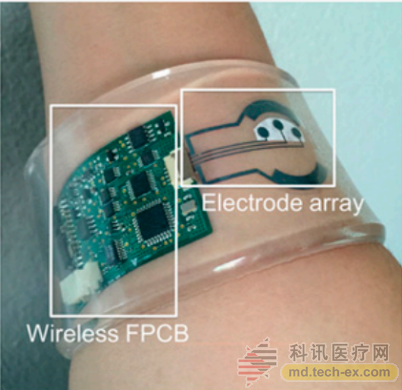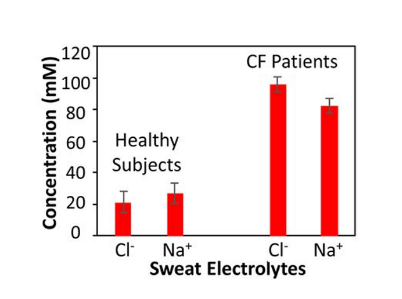Release date: 2017-05-08 At present, most of the smart bracelets on the market collect user's sports data and heartbeat, blood pressure and other data, and then display them in the form of APP, which satisfies consumers' pursuit of "fun" and "cool" to some extent. Unlike commercial products, Nature magazine has published an article that mentions that scientists at Stanford University and the University of California have developed a wearable smart device that can diagnose diseases, hoping only through the analysis of sweat. Achieve more comprehensive physiological monitoring and disease diagnosis for the human body [1]. Recently, these scientists have published the latest research results in the Journal of the National Academy of Sciences. Ronald Davis, a professor of biochemistry and genetics at Stanford University, and his friends say that the latest wristband devices with sensitive sensors and microprocessors can accurately diagnose diseases such as diabetes and cystic fibrosis. More interestingly, the new device actively stimulates the sweat gland to produce the trace amount of sweat required for detection without any discomfort [2]. The sweat that our body excretes is like a book containing a lot of information. The changes in the contents of various chemicals, such as electrolytes, heavy metals and proteins, can reveal the physiological changes that are taking place inside the human body [3]. For example, ethanol and glucose in sweat are closely related to ethanol and glucose in blood, and sweat chloride detection is a standard diagnostic procedure for cystic fibrosis. Sweat analysis has never been a new concept, but it is now necessary to collect sweat separately and send it to the laboratory for analysis using various instruments. Therefore, if there is a smart watch that can perform real-time data collection and analysis on human sweat, it can monitor the health of the user at the molecular level. This will have essential differences and absolute advantages with "smart medical" devices such as Fibit, Misfit, Apple Watch and various blood glucose meters! The idea is such an idea, but the real implementation is a complicated project. In order to achieve real-time capture of human sweat data in a non-invasive way, the research team developed a wearable sweat collection and sensing system, a sensor made of special plastic material as an interface to the skin, and a flexible circuit board. The silicon chip performs complex signal processing. Electrode array and wireless flexible printed circuit board (FPCB) There is a seemingly inconspicuous but important question. If you want to analyze sweat, you have to have "sweat". Especially for some people who don't like sports, it is a bit difficult to want them to provide enough sweat at any time. To this end, the research team designed an electrochemically enhanced iontophoretic interface to easily overcome this challenge. By sending a stimulating compound (such as pilocarpine) to the sweat glands with a weak current, a sufficient amount of sweat (in fact, 10 μL) is obtained [4]. And wireless programming control is implemented to induce sweating at different excretion rates and time intervals. After stimulating the sweat glands to generate enough sweat for a single monitoring, the sensing electrodes will immediately analyze the collected sweat components in the field, so that various key substances in the sweat (such as glucose, Na + and Cl - can also be recorded). The concentration of the concentration changes in real time. After the initial processing of the signal, the integrated circuit chip transmits the data to the smart phone via Bluetooth and uploads it to the cloud server for final analysis and diagnosis. This integrated, automated and programmable platform fully enables continuous, non-invasive and in situ monitoring of individuals, avoiding degradation, evaporation and contamination of sweat samples, as well as multi-tasking and programmable parameter adjustment. Features. This is not over yet. To solve the problem of health deciphering through human sweat, it is also necessary to solve problems such as "what substances are the key markers, what their concentration changes mean, and how to eliminate the difference between indicators". No wonder Ali Javey, a professor of electrical engineering and information science at the University of California, Berkeley, called this "hardware" research project "human big data project" [5]. Of course, we all understand that if a person has high levels of chloride ions in his sweat, he may have cystic fibrosis; if blood sugar is particularly high, it may mean diabetes. However, in order to achieve accurate diagnosis of the disease through these data, it is necessary to further verify the correlation between sweat reading and disease. To demonstrate the clinical value of the device, the research team conducted tests on human subjects. In a test conducted in 6 healthy volunteers and 3 patients with cystic fibrosis, healthy subjects had mean chlorine and sodium concentrations (based on 25-minute sensor readings) of 21.2 and 26.7 mM, respectively, and cystic fibrosis The patient's average chlorine and sodium levels (based on 25 minute sensor readings) were 95.7 and 82.3 mM, respectively. Comparison of diagnostic results between patients with cystic fibrosis and healthy patients To assess the utility of non-invasive glucose monitoring, the researchers performed real-time sweat glucose measurements on fasting and glucose-ingested subjects and compared them with blood glucose results measured using commercially available blood glucose meters. The results showed that after fasting for 12 hours and oral glucose for 1 hour, there was a significant correlation between blood glucose and "sweat" content in 7 subjects. In addition, the device can also be used to detect other molecular components of sweat, such as potassium and lactic acid, for the detection and diagnosis of other conditions. The researchers said that future work will increase the integration of temperature, pH and sweat sensors, taking into account differences between individuals to calibrate the measurements of various markers in sweat. Of course, the diagnosis of one or two diseases does not represent the true value of this device. Researchers are conducting large-scale clinical studies to further clarify the relationship between sweat readings and health. Large-scale clinical studies and big data analysis will help establish the relationship between the measurements of various components in sweat and the physiological state of the individual, paving the way for a sweat-based, non-invasive diagnostic approach for the general population. The current device can display the results through the APP interactive interface, email, and short message service, and further analyze and mine the data through the cloud service. The research team hopes to integrate this device into smart watches in the future for user convenience, thus enabling extensive population monitoring [6]. "Not only for disease diagnosis, but also for drug development." Professor Emaminejad of the University of California, Los Angeles, said [7], "Imagine that if you use a wearable sweat sensor in a clinical drug investigation, we can more easily Understand the physiological changes after administration."[1] http://[2] http:// /18/4625.full [3] Bandodkar AJ, Jeerapan I, Wang J (2016) Wearable chemical sensors: Present challenges and future prospects. ACS Sens. 1:464–482 [4] Farrell PM, et al. (2017) Diagnosis of cystic fibrosis: Consensus guidelines from the Cystic Fibrosis Foundation. J Pediatr 181S: S4–S15, 15.e1 [5] http://wearable.ofweek.com/2016-12/ART-8140-5004-30080193.html [6] http://med.stanford.edu/news/all-news/2017/04/wearable-sweat-sensor-can-diagnose-cystic-fibrosis.html [7] http:// Source: Singularity Network Vitamins: Various trace organic substances essential for the nutrition of most animals and some plants, especially as coenzymes and coenzyme precursors, which play a role in regulating metabolic processes, but they do not provide energy or serve as building blocks. Vitamins are found in natural foods or are sometimes produced in the human body. Vitamins Powder,Vitamin C Powder,Biotin Powder,Vitamin E Powder Shaanxi Zhongyi Kangjian Biotechnology Co.,Ltd , https://www.zhongyibiology.com

Vitamins are tiny molecules needed to keep the body functioning properly (vitamin B12 is the largest vitamin molecule, with a molecular weight of 1,355). In the article How sunburns and tans are formed, we learned that the body can make its own vitamin D, but usually the vitamin must be supplied through food.